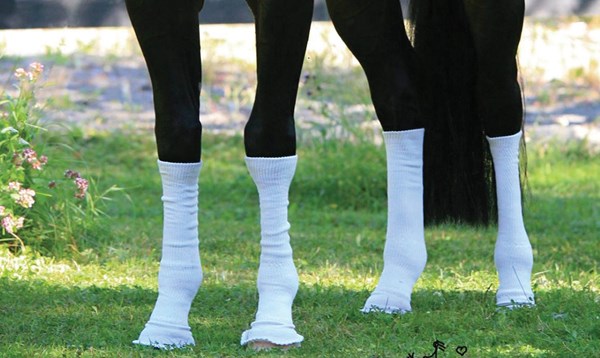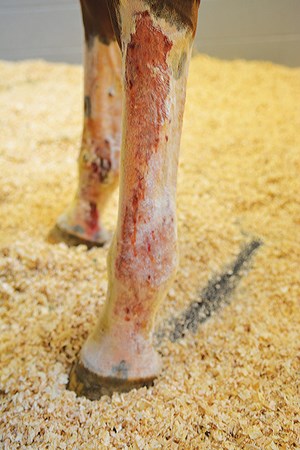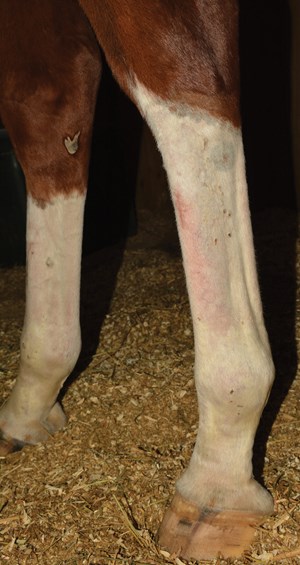 Credit: Courtesy Sox for Horses
Credit: Courtesy Sox for Horses“EPD is not a specific diagnosis. It is a syndrome. A term–scratches, dew poisoning, greasy heel, mud fever, foot rot, cracked heels–to describe cutaneous lesions caused by a variety of diseases that affect the lower legs of horses,” said award-winning veterinary dermatologist, research author and full Professor, Rosanna Marsella, DVM, of the University of Florida (Gainesville) College of Veterinary Medicine.
Marsella, who studies allergies and the identification of new therapies, is a 2006 recipient of the University of Florida Superior Accomplishment Award and researcher in immunology related to allergic skin diseases and atopic dermatitis (AD). In June 2014, she joined Drs. C. Johnson and K. Ahrens in publishing (Res. Vet. Sci.) the first case report on “Ultrastructural Cutaneous Abnormalities in Equine Atopic Dermatitis” and, in September 2013 she independently published (Vet. Clin. North Am. Equine Practice) “Equine Allergy Therapy: Update on Treatment of Environmental, Insect Bite Hypersensitivity and Food Allergies.”
Her research into AD, a common skin disease affecting humans and animals, looks at its pathogenesis in equines: “As cutaneous manifestations of AD exist across species, it is speculated that skin abnormalities may also exist in atopic horses.” At an EPD (Equine Pastern Dermatitis) conference earlier this year, she presented case studies and results using Silver Whinnys breathable pull-on leggings, knit with silver ion-embedded yarn by Sox For Horses, Inc., to address dermatitis issues.
Two years earlier, Raymond Petterson, president of Tallahassee, Florida-based Sox For Horses, invited the UF researcher to try his equine leg wear on her hardest-to-heal patients. The results, she said, delivered on their promise to protect sensitive skin during healing.
“One mare, in just a few days, was almost completely healed. I tried them on a chronic leg wound on a different horse, that had granulation tissue that would bleed and never close and had failed to improve with antibiotics, and after two days, the wound was no longer bleeding or thick around the edges. It went from fire-red to light pink and showing a thin epithelium. I was thrilled. This has incredible potential,” the veterinarian and researcher concluded for dermatological issues like summer sores (habronema), and discouraging secondary infection in non-healing wounds.
Sox For Horses Inc. was launched nearly a decade ago by Petterson, also a rescue horse and donkey owner, not only in response to a growing need for protective equine leg wear, but to help horses suffering from EPD and AD issues.
“I invented and manufacture Silver Whinnys in the United States using the most advanced silver yarn technology there is,” he explained, “giving the proprietary yarn in our pull-on leg defense system the ability to wick moisture off skin surfaces while keeping legs cool, and discouraging environments where fungus and bacteria propagate.
 Credit: Courtesy Sox for Horses Before…
Credit: Courtesy Sox for Horses Before…“Fresh air–instead of dirt and biting insects–is the only thing that is allowed to reach healing tissue,” he stated.
Veterinarians and owners are learning that equine dermatitis and secondary infection may demand prolonged research and discovery to identify and control their triggering factors. Changing a horse’s diet can offset feed-driven allergies, but other contributing factors may not be as simple, such as photosensitivity, allergies to pasture growth, long-term muddy footing,or a compromised immune system in response to environmental bacteria and fungi or disease spread by biting insects.
 Credit: Courtesy Sox for Horses After
Credit: Courtesy Sox for Horses After“Regardless of the inciting cause, secondary infections are a common complication and make the diagnostic and therapeutic process quite challenging,” said Marsella, citing staphylococcal infections and Dermatophilus, the bacteria causing rain rot, among her concerns. “Bacteria always take advantage of traumatized skin. The skin of horses with allergies (e.g., insect allergies) is very prone to secondary infections,” she said.
She also discussed with Petterson how the gentle compression offered by the unique knitted design might contribute to inhibiting exuberant granuloma or proud flesh.
The American Association of Equine Practitioners explains granuloma formation as a result of several factors–excessive movement of healing tissue, minimal soft tissue coverage around a wound, contamination (infection), reduced blood supply–especially critical to lower limbs, where there is very little soft tissue to protect wounds or provide a rich blood supply. Leg wounds are also more difficult to close via suturing because of a lack of extra skin, and they are more prone to contamination with bacteria since such injuries are closer to the ground, bedding and manure. Constant movement of a horse’s legs as it walks, turns and bears weight can also impair healing, especially over joints. When wounds occur in these areas, AAEP professionals urge, steps need to be taken immediately to prevent proud flesh.
Since Petterson began introducing veterinarians at the 2013 AAEP Convention to the protective pull-ons, and underscored by Marsella’s presentation in February, more equine care experts are considering pull-on (not bandage) equine leg wear as a breathable barrier between healing skin and its environment.
“So far, I’ve had unanimous success in alleviating every problem I’ve applied these Sox to,” said Steve Soule, DVM, with Palm Beach Equine Medical Centers of Florida and New York, and a U.S. Equestrian Federation Veterinarian since 1978.
“Leg sores have hit epidemic proportions in southern Florida, where flies never go away, and they are not responding to antibiotics as well as they used to,” Soule has noted, so in 2013, during the Winter Equestrian Festival season, he successfully used Silver Whinnys as a ‘breathing barrier’ between flies and his equine clients’ sores during healing.
The pull-on, wearable barriers, Petterson emphasized, do not “heal” per se, but create an environment that encourages healing. “They keep sores and wounds protected from disease-carrying flies and enviromental dirt, which is important when the next step in care is moving away from bandaging,” said Petterson. “It’s the antimicrobial silver in the yarn inhibiting the growth of bacteria and fungi in the socks, the breathable knit allowing air to reach the skin surface, and the moisture-managing property of the yarn that keeps skin surfaces dry that contribute to healing and recovery.”
For severe skin issues, such as EPD, Petterson suggested replacing the protected area with clean socks every 24 hours, and in extreme cases changing them twice daily.
“Silver Whinnys are much less expensive,” Soule emphasized, “than continuously bandaging horses. The costs of Vetrap, Elastikon or gauze on a daily or twice-daily basis adds up tremendously while in comparison, these can be removed daily and replaced with clean Sox. Sox can be laundered over and over, cutting back on another big expense related to bandaging.
“I recommend my clients leave the Sox on, covering the area at all times, including during exercise, and putting a clean one on daily until the wound heals,” contineud Soule. “It’s as easy as bringing a horse in after a workout, taking off the dirty Sox and replacing with a clean one, and being good to go.”
Sox for Horses Inc. has also taken on garment-building projects for dogs suffering from skin issues and welcomes special garment construction needs for any animal in need of relief from suffering due to dermatitis issues. Contact Sox For Horses, Inc. through www.soxforhorses.com or call 850-907-5724.
 Credit: Courtesy Sox for Horses Sox for Horses are easy to apply, washable and stay in place.
Credit: Courtesy Sox for Horses Sox for Horses are easy to apply, washable and stay in place.







